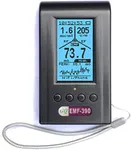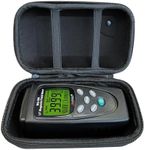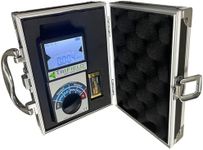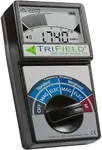Buying Guide for the Best Emf Meters
When choosing an EMF meter, it's important to understand what you're measuring and why. EMF meters are used to detect electromagnetic fields, which can be emitted by various electronic devices and power lines. The right EMF meter for you will depend on the type of EMF you want to measure, the range of frequencies you're interested in, and the level of accuracy you need. Consider where and how you plan to use the meter, as this will guide you in selecting the right features and specifications.Frequency RangeThe frequency range of an EMF meter indicates the span of electromagnetic frequencies it can detect. This is important because different sources emit EMFs at different frequencies. For example, power lines typically emit at lower frequencies, while cell phones and Wi-Fi operate at higher frequencies. When choosing an EMF meter, consider what sources you are most concerned about. If you're interested in measuring household appliances, a meter with a lower frequency range might suffice. For wireless devices, look for a meter that covers higher frequencies.
SensitivitySensitivity refers to the EMF meter's ability to detect weak electromagnetic fields. This is crucial if you need to measure low-level emissions or if you're in an area with minimal EMF presence. Sensitivity is often expressed in terms of the smallest field strength the meter can detect. If you're measuring in a typical home environment, moderate sensitivity might be adequate. However, for more precise measurements or in areas with low EMF levels, a higher sensitivity meter would be beneficial.
Type of EMF DetectedEMF meters can be designed to detect different types of electromagnetic fields, such as electric fields, magnetic fields, or radiofrequency fields. Understanding what type of EMF you need to measure is crucial. If you're concerned about power lines or electrical wiring, a meter that detects magnetic fields might be more appropriate. For concerns about wireless devices, look for a meter that can measure radiofrequency fields. Choose based on the specific sources of EMF you are interested in monitoring.
Display and ReadabilityThe display of an EMF meter shows the readings and is an important feature for ease of use. A clear, easy-to-read display can make it simpler to interpret the data, especially if you're not familiar with technical measurements. Some meters offer digital displays with backlighting, which can be helpful in low-light conditions. Consider how and where you'll be using the meter; if you're often in dim environments, a backlit display might be necessary. Also, think about whether you prefer digital or analog readouts.
Data Logging and ConnectivityData logging allows an EMF meter to record measurements over time, which can be useful for tracking changes or identifying patterns. Some meters also offer connectivity options, such as USB or Bluetooth, to transfer data to a computer or smartphone. This feature is particularly useful for detailed analysis or if you need to keep records of your measurements. If you plan to conduct long-term studies or need to analyze data, look for a meter with data logging capabilities. Otherwise, for occasional use, this feature might not be necessary.
















